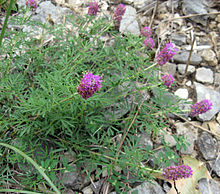| Dalea gattingeri | |
|---|---|

| |
|
Scientific classification
| |
| Kingdom: | Plantae |
| Clade: | Tracheophytes |
| Clade: | Angiosperms |
| Clade: | Eudicots |
| Clade: | Rosids |
| Order: | Fabales |
| Family: | Fabaceae |
| Subfamily: | Faboideae |
| Genus: | Dalea |
| Species: | D. gattingeri
|
| Binomial name | |
| Dalea gattingeri (A.Heller) Barneby
| |
Dalea gattingeri, commonly called purpletassles or Gattinger prairie clover, is a species of flowering plant in the legume family. It is native to the Southeastern United States, where it is restricted to limestone cedar glades of Tennessee, Alabama, Georgia, Missouri, and Arkansas. Its populations are widely dispersed and geographically small, with most populations being found in the Nashville Basin. [1]
It is a perennial that produces purple flowers in the summer. It has been shown to have alleopathic chemicals that inhibit the growth of nearby species Minuartia patula. [2]
References
- ^ a b NatureServe
- ^ Turner, Barbara Homan; Quarterman, Elsie (1978). "Allelochemic Effects of Petalostemon Gattingeri on the Distribution of Arenaria Patula in Cedar Glades". Ecology. 56 (4): 924–932. doi: 10.2307/1936302. JSTOR 1936302.
| Dalea gattingeri | |
|---|---|

| |
|
Scientific classification
| |
| Kingdom: | Plantae |
| Clade: | Tracheophytes |
| Clade: | Angiosperms |
| Clade: | Eudicots |
| Clade: | Rosids |
| Order: | Fabales |
| Family: | Fabaceae |
| Subfamily: | Faboideae |
| Genus: | Dalea |
| Species: | D. gattingeri
|
| Binomial name | |
| Dalea gattingeri (A.Heller) Barneby
| |
Dalea gattingeri, commonly called purpletassles or Gattinger prairie clover, is a species of flowering plant in the legume family. It is native to the Southeastern United States, where it is restricted to limestone cedar glades of Tennessee, Alabama, Georgia, Missouri, and Arkansas. Its populations are widely dispersed and geographically small, with most populations being found in the Nashville Basin. [1]
It is a perennial that produces purple flowers in the summer. It has been shown to have alleopathic chemicals that inhibit the growth of nearby species Minuartia patula. [2]
References
- ^ a b NatureServe
- ^ Turner, Barbara Homan; Quarterman, Elsie (1978). "Allelochemic Effects of Petalostemon Gattingeri on the Distribution of Arenaria Patula in Cedar Glades". Ecology. 56 (4): 924–932. doi: 10.2307/1936302. JSTOR 1936302.
